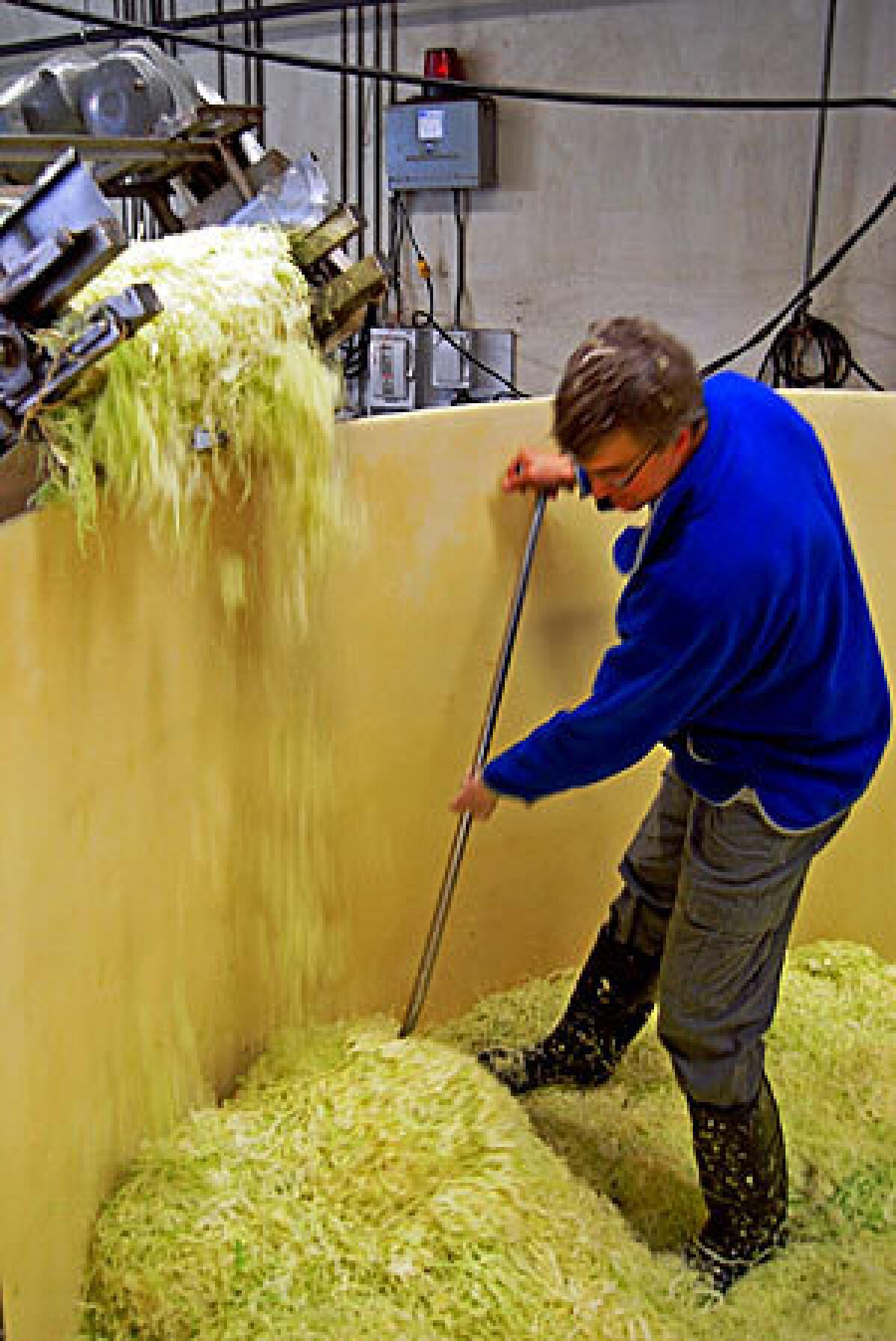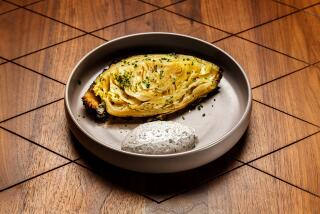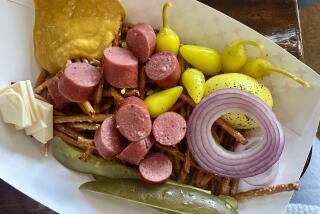Kruegermann family’s peck of pickled products

- Share via
Kurt Kruegermann sits in the driver’s seat of a weather-beaten forklift as it slowly sputters to life. A few minutes later, the 77-year-old co-owner of Krüegermann Pickles & Sauerkraut flips a switch and a cardboard box filled with 1,500 pounds of cabbage drops with a thunderous clap onto a metal sorting table.
Like the one-per-punch cabbage coring machine and the decades-old bottling line at the Glassell Park pickling factory, the forklift is covered in battle scars from a few too many run-ins with errant basketball-sized cabbages and 2-foot-long cucumbers. Replacing the equipment with more technologically advanced machinery would mean more jars of red chile-spiced uborka pickles (Hungarian-style cucumber pickles) and tangy-sweet rote beete (pickled red beets) rolling off the bottling line, but for the Kruegermann family, the trick to making a pause-worthy pickle is more about a good old-fashioned virtue: patience.
“The American way is faster, always doing more and more,” says Kurt, who grew up in Lübbenau, a small German town southeast of Berlin nestled amid pickling-friendly cabbage, cucumber and beet farms. “I prefer to go slower, focus on one thing at a time.”
That eagle-eye focus was a little easier almost 45 years ago when Kurt and his wife, Helga, began making small batches of frischgurken (lightly sweetened “fresh pack” pickles), rotkohl (sweet and sour red cabbage with apples) and naturally fermented sauerkraut out of their Glassell Park home to sell at neighborhood markets. Today, the couple and their two sons, 50-year-old Greg and his younger brother, Carl, 45, produce more than two dozen varieties of pickled vegetables for specialty grocers, supermarkets and delicatessens in the U.S.
Kurt built the original factory, as well as the first vegetable processing and canning equipment, from scrap metal. “I used to tell him he was only giving money to the junkyard,” a smiling Helga recalls in syrupy, German-soaked English, sitting behind her desk in the small office space where she fields wholesale orders.
“If you have a handy person who knows how to weld things and build machinery . . . you don’t have to spend much money when you start over,” Kurt matter-of-factly replies.
In 1961, right before East Germany’s ruling party seized the pickle company that Kurt’s grandfather had founded in 1896, the young couple moved with Greg, then 3, to live in Eagle Rock with Helga’s mother, who had immigrated to the Los Angeles area two years earlier. Kurt’s brother Ernst Krügermann stayed behind to manage an agricultural cooperative in East Germany. (The extra “e” in the name Kruegermann was added when the family moved to California).
“We couldn’t take anything -- nothing -- from communist Germany,” Kurt says.
A fresh start
Kurt picked up enough English from watching television to land a job mixing seasoned salts for Lawry’s, the Los Angeles-based spice company and steakhouse chain. Two years later, the couple purchased a home in nearby Glassell Park, where they began making small batches of frischgurken and sauerkraut (the home was later demolished to make room for the current production plant). In 1965, the family began selling its pickles commercially.
“Kurt would go to the market at 5 in the morning to get cucumbers for pickles; I would shred cabbage by hand at home,” says Helga, who recruited pickling-savvy German girlfriends to help seal and sterilize the jars of finished pickles and kraut.
Today, in a typical week during the height of spring cabbage season, the company produces 100,000 pounds of sauerkraut.
“Dad got this in the 1970s -- we still bring back blades from Germany,” says Greg, proudly patting the rudimentary machine where an employee is loading cabbages one by one into the 6-inch coring device.
Carl is knee-deep in spaghetti-thin strands of cabbage (an heirloom variety grown by Edna Valley, Calif., farmers from seeds imported from Germany) in a 35,000-gallon plastic tub on the opposite end of the coring and shredding machine. “You can’t have just anyone in here salting.”
As the strands fall from the shredder overhead, he sprinkles the cabbage lightly with sea salt and rakes it occasionally to aerate the mixture.
“When you’re dealing with only two ingredients, all of your flavor compounds come from the lactic acid . . . salt is key to getting that natural fermentation going,” says Carl, a graduate of UC Davis’ Food Science & Technology program.
Naturally fermented sauerkraut has a subtle, delicate tang that varies slightly from batch to batch, much like home-brewed beer. (Mass-produced krauts get their stronger hit of acidity and uniform flavor from added vinegar.)
Oh, those bubbles
As if on cue, nearby small tubs of last week’s carefully salted cabbage are gurgling yeasty bubbles beneath the large granite stones weighting down their lids (fermentation is powerful stuff). In three to four weeks, jars of the finished kraut will be sealed in an automated sterilizing and vacuum-sealing machine, one of the few nods the Kruegermanns have made to modernization. Until recently, thousands of jars of the pickled vegetables were bottled in small batches by hand, similar to home canning and preserving.
“We’re lucky cabbages and cucumbers grow at different times of year,” says Greg, only half joking.
Over the years, some classic pickle products have not fared as well as kraut and frischgurken in the U.S. as they have in Germany. (Kurt’s brother re-opened the original pickle factory a few months after the 1989 fall of the Berlin Wall.)
“We’ll make a couple hundred jars of some products mainly for our German customers,” Carl says between bites of Helga’s homemade quark, the fresh German curd cheese that she often serves with lunch (here, blended with sour cream and drizzled with toasted linseed, or flax seed, oil).
The Kruegermanns have adapted to the dwindling market for traditional products such as naturally fermented dills (today, most commercial pickles, including Kruegermann varieties, contain vinegar and spices) by introducing hybrid pickled vegetables such as the spicy “fiesta mix,” a picnic-ready side dish of sliced pickles, carrots, onions and red peppers; as well as giant jars of ready-made, delicatessen-friendly minced frischgurken for potato salads.
The family knows the patience for hand-peeling and seeding 2-foot-long heirloom cucumbers to make senfgurken (mustard pickles in onion brine) for a dwindling audience may not trickle down to the next generation of potential Kruegermann picklers: 12-year-old Makala, 8-year-old Kristina and 6-year-old Eric. But their father, Greg, is hopeful.
“Eric likes the forklift.”
More to Read
Eat your way across L.A.
Get our weekly Tasting Notes newsletter for reviews, news and more.
You may occasionally receive promotional content from the Los Angeles Times.










